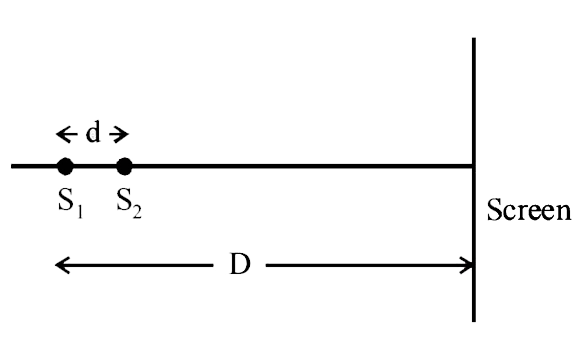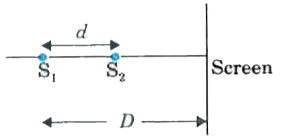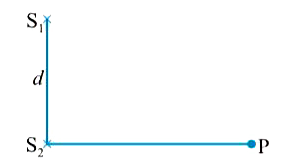In Fig. , two point sources S1 and S2 which are in phase and separated by distance D=1.5λ , emit identical sound waves of wavelength λ.
(a) What is the path length difference of the waves from S1 and S2 at point P1, which lies on the perpendicular bisector of distance D, at a distance greater than D from the sources ? (That is, what is the difference in the distance from source S1 to point P1 and the distance from source S2 to P1?) What type of interference occurs at P1 ?
(b) What are the path length difference and type of interference at point P2 in fig.
(c ) Figure shows a circle with a radius much greater than D, centered on the midpoint between sources S1 and S2. What is the number of points N around this circle at which the interference is fully constructive? (That is, at how many points do the waves arrive exactly in phase?)
(a) Because the waves travel identical distances to reach P1 their path length difference is ΔL=θ
From Eq., this means that the waves undergo fully constructive interference at P1 because they start in phase at the sources and reach P1 in phase.
(b) The wave from S1 travels the extra distance D(=1.5λ) to reach P2 Thus, the path length difference is
ΔL=1.5λ
this means that the waves are exactly out of phase at P2 and undergo fully destructive interference there.

(c )Starting at point a, let.s move clockwise along the circle to point d. As we move, path length difference ΔL increases and so the type of interference changes. From (a), we know that is ΔL=0λ at point a. From (b), we know that ΔL=1.5λ at point d. Thus, there must be one point between a and d at which ΔL=λ
From Eq. , fully constructive interference occurs at that point. Also, there can be no other point along the way from point a to point d at which fully constructive interference occurs, because there is no other integer than 1 between 0 at point a and 1.5 at point d. We can now use symmetry to locate other points of fully constructive or destructive interference. Symmetry about line cd gives us point b, at which ΔL=0λ . Also, there are three more points at which ΔL=λ . In all we have
N = 6.
Topper's Solved these Questions
- BOOK - RESNICK AND HALLIDAYCHAPTER - WAVE - IIEXERCISE - CHECKPOINTS4videos
WAVE - II
- BOOK - RESNICK AND HALLIDAYCHAPTER - WAVE - IIEXERCISE - PROBLEMS59videos
WAVE - II
- BOOK - RESNICK AND HALLIDAYCHAPTER - VECTORS EXERCISE - PRACTICE QUESTIONS39videos
VECTORS
- BOOK - RESNICK AND HALLIDAYCHAPTER - WAVES-IEXERCISE - Practice Questions (Integer Type)4videos
WAVES-I
Similar Questions
Knowledge Check
- Question 1 - Select One
Two coherent point sources S1 and S2 are separated by a small distance d as shown. The fringes obtained on the screen will be
 ApointsBstraight linesCsemi-circlesDconcentric circles
ApointsBstraight linesCsemi-circlesDconcentric circles - Question 2 - Select One
Two coherent point sources S1andS2 are separated by a small distance 'd' as shown. The fringes obtained on the screen will be :
 Astraigth linesBsemi-circleCconcentric circlesDpoints
Astraigth linesBsemi-circleCconcentric circlesDpoints - Question 3 - Select One
Waves of wavelength λ are generated on the water surface. The phase difference between two points at a distance of λ is
Aπ radianB2π radianCπ2 radianDπ6 radian
Two coherent sources S1 and S2 are separated by a small distance d. The fringes obtained on the screen will be:
 View Solution
View SolutionWaves of wavelength λ are generated on the water surface. The phase difference between two points at a distance of λ is
View SolutionS1andS2 are two sources of light separated by a distance d. A detector can move along S2 P perpendicular to S1S2. What should be the minimum and maximum path difference at the detector?
 View Solution
View SolutionTwo monochromatic coherent point sources S1 and S2 are separated by a distance L. Each sources emits light of wavelength λ, where L>>λ. The line S1S2 when extended meets a screen perpendicular to it at point A. Then
View SolutionTwo monochromatic coherent point sources S1 and S2 are separated by a distance L. Each sources emits light of wavelength λ, where L>>λ. The line S1S2 when extended meets a screen perpendicular to it at point A. Then
View Solution

